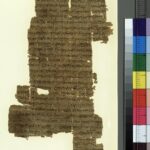| Artefact ID | 631 |
| TM ID | TM 61788 |
| Findspot (DEChriM ID) | - () | Class | Textual |
| Material | Papyrus |
| Writing medium | Codex |
| Text content | Literary |
| Language | Greek |
| Description | P.Mich. III 137; 𝔓37; Gregory-Aland P37; NT37 Papyrus fragment containing the Gospel of Matthew 26:19-52., depicting the Last Supper, the betrayal by Judas, and parts from the beginning of the Arrest of Jesus. The fragment (originally two fragments joined to complete one folio) measures 12.1 x 22.4 cm, and contains text written in one column with 33 (recto) and 32 (verso) lines of text per column. The original amount of lines to a column is estimated to have been 33. The original size was probably 25 x 15 cm. There is one rough breathing (see l. 8 on the recto), but no further accents. Diaereses appear rarely. Punctuation is indicated by enlarged spaces between certain phrases. These pauses have been further marked by diagonal strokes (similar to acute accents) which were a later addition, probably by a second hand, and intended as dialectical aids. These marks do not appear to coincide with stichoi. The text contains several nomina sacra. The ed. pr. classifies the text as an example of the Western type, with which the folio agrees concerning 56 out of 84 variants. The hand is described as highly cursive, but shows few ligatures and links, and is associated by ed. pr. with documentary-styled letter writing. |
| Selection criteria | Literary genre (Biblical), Nomina sacra |
| Date from | 250 |
| Date to | 299 |
| Dating criteria | Palaeography. The ed. pr. placed the fragments in the 3rd c., with a suggestion of narrowing it down to the latter half of the century. The date was later expanded to include the 4th c. (see Aland 1967: 119). The fragment has sincebeen placed in the second half of the 3rd c. by the palaeographers W. Clarysse and P. Orsini; see Clarysse / Orsini 2012: 470. |
| Absolute/relative date | Relative date |
| Archaeological context | The provenance is possibly in the Arsinoites (Fayûm), as posited by Clark 1937: 334-335. The fragments were purchased in Cairo in 1924; see ref. ed. |
| Accession number | Ann Arbor, Michigan University, Library P. 1570 |
ARTEFACT IDENTIFIERS
Reference edition:
∙ Sanders, Henry A. 1936. Michigan Papyri III: Miscellaneous Papyri. Winter, J. G. et al., eds. Ann Arbor (Michigan). 9-14, papyrus no. 137 and plate no. 1.
Editio princeps:
∙ Sanders, Henry A. 1926. "An Early Papyrus Fragment of the Gospel of Matthew in the Michigan Collection". Harvard Theological Review 19 (3). 215-216.
Additional bibliography:
· Aland, Kurt. 1967. Studien zur Überlieberung des Neuen Testaments und seines Textes. Berlin: De Gruyter. 119.
∙ ———. 1976. Repertorium der griechischen christlichen Papyri: 1. Biblische Papyri: Altes Testament, Neues Testament, Varia, Apokryphen. Neues Testament 37.
∙ Bover, José Maria. 1930. "Dos papiros egipcios del N.T. recién publicados". Estudios eclesiásticos 9. 289-330.
∙ Clark, Kenneth Williams. 1937. A descriptive catalogue of Greek New Testament manuscripts in America. Chicago. 334-335.
∙ Clarysse, Willy and Pasquale Orsini. 2012. "Early new testament manuscripts and their dates: A critique of theological palaeography". Ephemerides Theologicae Lovanienses 88. 443-474.
∙ Comfort, Philip W. and David P. Barrett. 1999. The complete text of the earliest New Testament manuscripts. Grand Rapids, Michigan. 130-133.
· Crisci, Eduardo. 2005. "Note sulla più antica produzione di libri cristiani nell'oriente greco". Segno e testo 3. 144 n. 157.
· Günther, Zuntz. 1949. "A Note on Matthew XXVI. 34 and XXVI". JTS 50. 75.
∙ Jaroš, Karl. 2006. Das Neue Testament nach den ältesten griechischen Handschriften (CD-Rom). Wien-Würzburg: Echter. 3750-3769, no. 2.7.
∙ Min, Kyoung Shik. 2005. Die früheste Überlieferung des Matthäusevangeliums (bis zum 3./4. Jh.). Berlin, Boston: De Gruyter. 83-110.
∙ van Haelst, Joseph. 1976. Catalogue des papyrus littéraires juifs et chrétiens. Paris. Description no. 378.


 Json data
Json data





